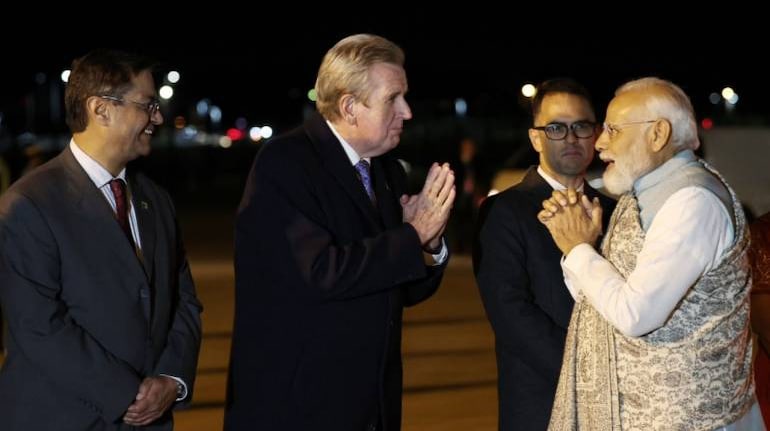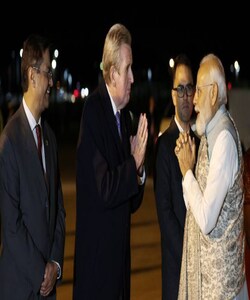
PM Modi arrived last evening to a rapturous welcome as he was warmly received by senior Australian officials and a large number of the Indian diaspora.
An enhanced security cooperation and ways to elevate trade and economic relations in a region where China’s aggression is a serious concern will be the key elements in Prime Minister Narendra Modi’s three-day visit to Australia that began on Tuesday, May 23.
“As two democracies, India and Australia have shared interests in a free, open and inclusive Indo-Pacific,” Modi told the local newspaper—the Australian on the eve of his arrival.
The Indian Prime Minister arrived last evening to a rapturous welcome as he was warmly received by senior Australian officials and a large number of the Indian diaspora.
This is Modi’s last leg of the three-nation tour. He began his journey on May 19 with a visit to Hiroshima for the Group of Seven (G7) summit as a special invitee before travelling to Papua New Guinea for a summit at the Forum for the India-Pacific Island Cooperation (FIPIC) with 14 island-nations in the Pacific Ocean.
The agenda
During his engagement with the Australian Prime Minister Anthony Albanese, Modi will deliberate on building resilient supply chains that have been disrupted due to the COVID-19 pandemic, the Ukraine war, and an open and secured Indo-Pacific.
Also Read | PM Modi meets business leaders in Sydney; invites investments in India
“There is alignment of our strategic viewpoints,” Modi said. According to the Indian Prime Minister, “The high degree of mutual trust between us has naturally translated into greater cooperation on defence and security matters.”
He added, “Our navies are participating in joint naval exercises.”
On the eve of Modi’s arrival, his Australian counterpart also called for an “open, secure, and prosperous” Indo-Pacific region.
Modi told the newspaper in his interview, “I am confident that when we are together again in Sydney, we will get the opportunity to explore how we can take our relations to the next level, identify new areas of complementariness and can expand our cooperation.”
A major area will be to enhance trade and economic cooperation and elevate the India-Australia Economic Cooperation and Trade Agreement that came into force in December 2022. The attempt will be to increase the current trade volume from $30 billion to $100 billion in a decade.
This is Modi’s second visit to the country since 2014. But this will be his fourth meeting with the Australian Prime Minister Anthony Albanese since he came to power in May last year.
“I am not a person who gets satisfied easily,” Modi told the Australian. He pointed out, “I have seen that Prime Minister Albanese is the same.”
Also Read | Industry leaders in Australia hail PM Modi’s zeal for India
This was an indication that both sides will try to make the best of this visit to elevate the bilateral relations to an even higher level and expand cooperation in a number of areas of mutual interest.
Modi is also scheduled to address a gathering of the Indian diaspora in Sydney and a business meeting where leading CEOs of Australian companies are likely to be present.
Beyond Quad
The Indian Prime Minister’s visit to Australia was primarily for the Quad summit which also has America and Japan, besides the two countries, as members.
But the US President had to cut short his visit after the G7 summit in Japan and return home because of an evolving economic debt crisis. This led the Quad countries to meet in Hiroshima.
Modi could have avoided visiting Australia and returned home from Hiroshima.
But he went ahead with his visit to Sydney for two reasons. He was keen to attend the summit of the FIPIC and did not want to disappoint the leaders of these islands who too were looking forward to the important meeting.
Also Read | Want to take relations with Australia to ‘next level’: PM Modi
The second reason has to do with the growth trajectory in Indo-Australian relations, which officials in Delhi describe as the most “transformative” relation among all the Quad countries in the past decade.
Growing bonhomie
Despite being former British colonies, English-speaking nations and having a common passion for the game of cricket, India and Australia had maintained a cordial but indifferent relationship.
During the Cold War period, India considered Australia as an outpost of the Americans and Canberra regarded New Delhi as a close ally of the Soviet Union. Though relations started to pick up in the early 1990s when India began its economic liberalisation, they really took off after Modi became the first Indian Prime Minister after Rajiv Gandhi to visit the country in 2014.
Since then, there have been steady high-level visits between the two sides as both countries realised that they had much to gain from their friendship. Australia is an abundant, resource-rich country and India needs a lot of those resources for its growth and development.
India imported 21.5 percent of Australian thermal coal worth Au $13. 7 billion and Au $12.1 billion worth of its metallurgical coal in 2021. There will also be a discussion on how to expand cooperation on clean energy.
Besides, about 30,000 Indians are studying in Australia, making it the second-largest international student group in the country. The Indian diaspora is the second-largest ethnic group in the country after Britain.
The IMF projection of India with its current growth at 6.1 percent overtaking the UK as the world’s fifth-largest economy and predictions of it becoming the third-largest economy in a decade have also been a strong reason for Australia’s current interest in strengthening its partnership with India.
Though Australia is a treaty ally of the US, India has maintained an independent strategic space.
But besides a strong, attractive market with a young pool of skilled workers, India’s attraction to Australia also comes from its independent foreign policy that does not allow Delhi to accept any country to dominate the free movement in the Indo-Pacific—the lifeline for growth and development for both countries.
The commitment of the two countries to maintain this status quo is likely to be highlighted once again during the Indian Prime Minister’s ongoing visit to Australia.

